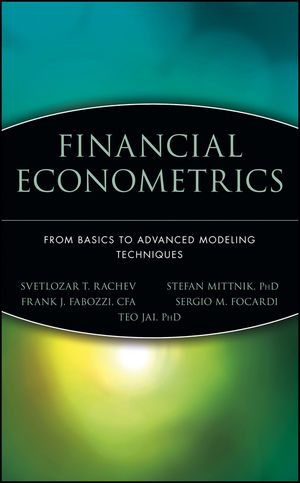|
Textbook
Financial Econometrics: From Basics to Advanced Modeling TechniquesISBN: 978-0-471-78450-0
Hardcover
576 pages
December 2006, ©2007
 This is a Print-on-Demand title. It will be printed specifically to fill your order. Please allow an additional 10-15 days delivery time. The book is not returnable.
|
||||||
Abbreviations and Acronyms.
About the Authors.
CHAPTER 1: Financial Econometrics: Scope and Methods.
The Data Generating Process.
Financial Econometrics at Work.
Time Horizon of Models.
Applications.
Appendix: Investment Management Process.
Concepts Explained in this Chapter (in order of presentation).
CHAPTER 2: Review of Probability and Statistics.
Concepts of Probability.
Principles of Estimation.
Bayesian Modeling.
Appendix A: Information Structures.
Appendix B: Filtration.
Concepts Explained in this Chapter (in order of presentation).
CHAPTER 3: Regression Analysis: Theory and Estimation.
The Concept of Dependence.
Regressions and Linear Models.
Estimation of Linear Regressions.
Sampling Distributions of Regressions.
Determining the Explanatory Power of a Regression.
Using Regression Analysis in Finance.
Stepwise Regression.
Nonnormality and Autocorrelation of the Residuals.
Pitfalls of Regressions.
Concepts Explained in this Chapter (in order of presentation) .
CHAPTER 4: Selected Topics in Regression Analysis.
Categorical and Dummy Variables in Regression Models.
Constrained Least Squares.
The Method of Moments and its Generalizations.
Concepts Explained in this Chapter (in order of presentation).
CHAPTER 5: Regression Applications in Finance.
Applications to the Investment Management Process.
A Test of Strong-Form Pricing Efficiency.
Tests of the CAPM.
Using the CAPM to Evaluate Manager Performance: The Jensen Measure.
Evidence for Multifactor Models.
Benchmark Selection: Sharpe Benchmarks.
Return-Based Style Analysis for Hedge Funds.
Hedge Fund Survival.
Bond Portfolio Applications.
Concepts Explained in this Chapter (in order of presentation).
CHAPTER 6: Modeling Univariate Time Series.
Difference Equations.
Terminology and Definitions.
Stationarity and Invertibility of ARMA Processes.
Linear Processes.
Identification Tools.
Concepts Explained in this Chapter (in order of presentation).
CHAPTER 7: Approaches to ARIMA Modeling and Forecasting.
Overview of Box-Jenkins Procedure.
Identification of Degree of Differencing.
Identification of Lag Orders.
Model Estimation.
Diagnostic Checking.
Forecasting.
Concepts Explained in this Chapter (in order of presentation).
CHAPTER 8: Autoregressive Conditional Heteroskedastic Models.
ARCH Process.
GARCH Process.
Estimation of the GARCH Models.
Stationary ARMA-GARCH Models.
Lagrange Multiplier Test.
Variants of the GARCH Model.
GARCH Model with Student’s t-Distributed Innovations.
Multivariate GARCH Formulations.
Appendix: Analysis of the Properties of the GARCH(1,1) Model.
Concepts Explained in this Chapter (in order of presentation).
CHAPTER 9: Vector Autoregressive Models I.
VAR Models Defined.
Stationary Autoregressive Distributed Lag Models.
Vector Autoregressive Moving Average Models.
Forecasting with VAR Models.
Appendix: Eigenvectors and Eigenvalues.
Concepts Explained in this Chapter (in order of presentation).
CHAPTER 10: Vector Autoregressive Models II.
Estimation of Stable VAR Models.
Estimating the Number of Lags.
Autocorrelation and Distributional Properties of Residuals.
VAR Illustration.
Concepts Explained in this Chapter (in order of presentation).
CHAPTER 11: Cointegration and State Space Models.
Cointegration.
Error Correction Models.
Theory and Methods of Estimation of Nonstationary VAR Models.
State-Space Models.
Concepts Explained in this Chapter (in order of presentation).
CHAPTER 12: Robust Estimation.
Robust Statistics.
Robust Estimators of Regressions.
Illustration: Robustness of the Corporate Bond Yield Spread Model.
Concepts Explained in this Chapter (in order of presentation).
CHAPTER 13: Principal Components Analysis and Factor Analysis.
Factor Models.
Principal Components Analysis.
Factor Analysis.
PCA and Factor Analysis Compared.
Concepts Explained in this Chapter (in order of presentation).
CHAPTER 14: Heavy-Tailed and Stable Distributions in Financial Econometrics.
Basic Facts and Definitions of Stable Distributions.
Properties of Stable Distributions.
Estimation of the Parameters of the Stable Distribution.
Applications to German Stock Data.
Appendix: Comparing Probability Distributions.
Concepts Explained in this Chapter (in order of presentation).
CHAPTER 15: ARMA and ARCH Models with Infinite-Variance Innovations.
Infinite Variance Autoregressive Processes.
Stable GARCH Models.
Estimation for the Stable GARCH Model.
Prediction of Conditional Densities.
Concepts Explained in this Chapter (in order of presentation).
APPENDIX: Monthly Returns for 20 Stocks: December 2000–November 2005.
INDEX.



